There is a fantastic photo that says everything cool about being
a test pilot in the 60s - it shows Bill Dana in a silver pressure suit,
standing on a dry lake bed next to a futuristic looking wingless craft,
with a very 60s silver and white-swoosh paint job, as a monster B-52
roars overhead at low altitude, streaming black exhaust into the blue
desert sky. You can see the picture from the link under references; the
futuristic looking wingless craft is the Northrop HL-10 "lifting body".
The lifting bodies were a little-known aerospace program that
made a major contribution to the design of the Space Shuttle. Even
during the heyday of Gemini and Apollo, the US realised that the
one-shot approach to space travel, where every single item had to be
built from scratch for every mission, was ultimately unsustainable. If
space was to become routinely accessible, and maybe even commercialised,
a re-usable system was needed. One of the many consequences of this idea
was that the spaceship needed to be able to come down to earth and land
in some controlled way, rather than splashing down under parachutes and
being recovered by an aircraft carrier.
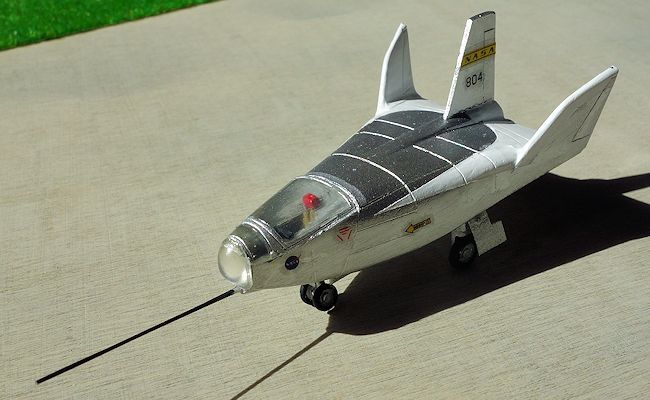 Before
that could happen, NASA needed information about the designs that might
achieve this. One solid line of thought was the "lifting body" - a plane
without wings that could still generate lift, preferably from a shape
that could also function as a heat shield.
Before
that could happen, NASA needed information about the designs that might
achieve this. One solid line of thought was the "lifting body" - a plane
without wings that could still generate lift, preferably from a shape
that could also function as a heat shield.
The program had actually started with the M2-F1, a wooden glider that
was towed behind a hotted up Pontiac, and later behind an aeroplane, to
verify that such a thing could even fly. It could, and so Northrop won a
contract to build the HL-10 and the M2-F2. These aircraft were carried
to altitude by a larger plane like a B-52, then they were dropped. The
rocket kicked in, carrying the plane to a greater height, and then it
glided back down, often supersonically, before slowing down to land.
The HL-10 had its first gliding flight on 22 December 1966 and fired its
rocket for the first time on its 12th flight, 23 October 1968. In all,
the HL-10 flew 37 times. Its fastest speed was Mach 1.86, which was the
record for any lifting body, and its best height, also the best for any
lifting body, was just a fraction over 90,000 feet.
The HL-10 survives and is displayed at
Dryden Flight Research Center, Edwards AFB.
I
previewed this cool little combo set from Anigrand
right here on MM.
The first thing to remember is that there are four other
lifting bodies in the com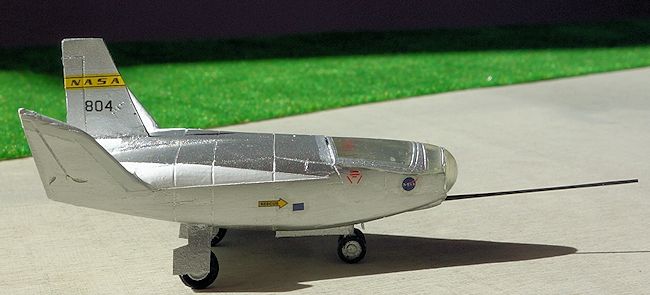 bo
set, which reduces the sticker shock a little bit. I have
already built the HL-20 which you can see
right here on MM
.
bo
set, which reduces the sticker shock a little bit. I have
already built the HL-20 which you can see
right here on MM
.
The HL-10 has a single piece body, three tailfins,
canopy parts and undercarriage, plus a long air data probe.
There is a cockpit cavity with a simplistic rendition of an
ejector seat.
I didn't
realise until I started the kit that there are not enough yellow
NASA stripes to go around. The thinner ones fit the HL-10 and
M2-F2/3, but you need thicker ones for both the X-24A and B
(unless you do the -A in the scheme with white rudders, as
pictured on the box instead of the totally bare metal scheme set
out in the instructions). I ordered another sheet from Anigrand
when I bought another kit from them later on.
There isn't much to building this
lifting body. Wearing a safety mask, I sanded down the seams on
the resin body, and tidied up the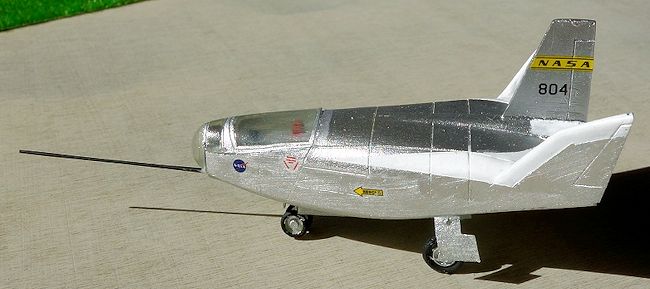 winglets or tailfins (not exactly sure what these technically
should be called...). Then, using superglue, I assembled the
body. About 90 seconds later, primary construction was complete!
Later, more sanding, although the fit really is pretty good, and
then I was ready to paint my HL-10.
winglets or tailfins (not exactly sure what these technically
should be called...). Then, using superglue, I assembled the
body. About 90 seconds later, primary construction was complete!
Later, more sanding, although the fit really is pretty good, and
then I was ready to paint my HL-10.
After painting, I installed the undercarriage, added the
two canopy sections (be careful to align it better than I did)
and then made some new undercarriage doors from plastic card.
The kit's ones are way too thick. Last of all I used some
stretched sprue for the long air data probe. The kit comes with
one but it is a bit thick and was also bent.
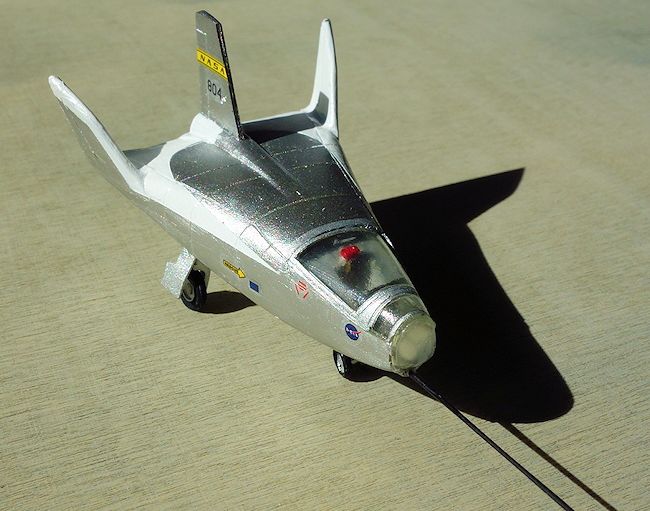 Pictures
show the aircraft to be bare metal, fairly shiny. In some
pictures it also has the white tailfins and side stripes, as I
have done here. Although this thing is very small, and sits
happily on the palm of my hand, I still chose to spray paint it
with a blast top and bottom of Tamiya gloss aluminium. After
that, I used some masking tape and I brushpainted the white area
using Tamiya gloss white X-2. Inside, I used a medium grey for
the cockpit and black for a scratchbuilt instrument panel (which
might have been grey on the real thing, actually). The head of
the ejection seat is red. Undercarriage is just Tamiya aluminium.
Pictures
show the aircraft to be bare metal, fairly shiny. In some
pictures it also has the white tailfins and side stripes, as I
have done here. Although this thing is very small, and sits
happily on the palm of my hand, I still chose to spray paint it
with a blast top and bottom of Tamiya gloss aluminium. After
that, I used some masking tape and I brushpainted the white area
using Tamiya gloss white X-2. Inside, I used a medium grey for
the cockpit and black for a scratchbuilt instrument panel (which
might have been grey on the real thing, actually). The head of
the ejection seat is red. Undercarriage is just Tamiya aluminium.
Anigrand's decals work ok. There are not many markings
on the plane anyway, although the data labels aft of the yellow
rescue arrow aren't included. Nor is the serial number N804NA
which goes just above the main wheel door, and, while I'm at it,
there ought to be a NORTHROP sign just aft of the NASA meatball
near the canopy, and a BEWARE OF BLAST on the rump, a bit above
and behind where the N804NA should be. But never mind, you get
most of the decals and the model really is very small.
A cool lifting body and a fantastic compilation set from
Anigrand. Easy to build, great for your first go at resin, or if
you like real space or just something out of the ordinary on
your shelf-top flightline. Recommended.
Good pics of the HL-10 here.
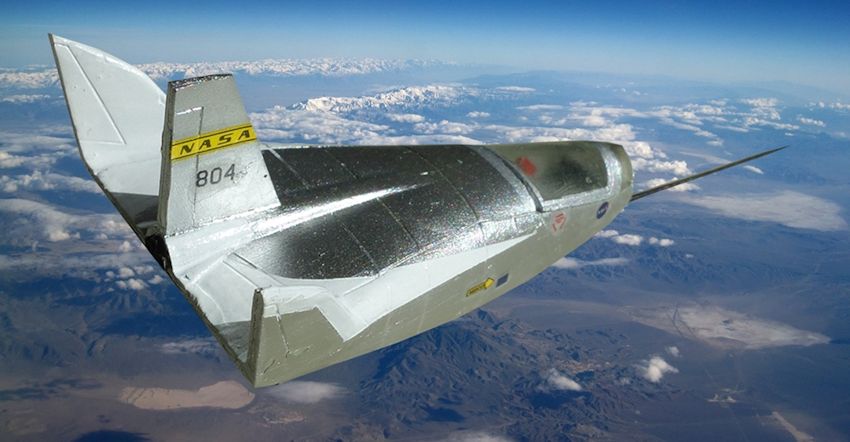

 Before
that could happen, NASA needed information about the designs that might
achieve this. One solid line of thought was the "lifting body" - a plane
without wings that could still generate lift, preferably from a shape
that could also function as a heat shield.
Before
that could happen, NASA needed information about the designs that might
achieve this. One solid line of thought was the "lifting body" - a plane
without wings that could still generate lift, preferably from a shape
that could also function as a heat shield. bo
set, which reduces the sticker shock a little bit. I have
already built the HL-20 which you can see
right here on MM
.
bo
set, which reduces the sticker shock a little bit. I have
already built the HL-20 which you can see
right here on MM
. winglets or tailfins (not exactly sure what these technically
should be called...). Then, using superglue, I assembled the
body. About 90 seconds later, primary construction was complete!
Later, more sanding, although the fit really is pretty good, and
then I was ready to paint my HL-10.
winglets or tailfins (not exactly sure what these technically
should be called...). Then, using superglue, I assembled the
body. About 90 seconds later, primary construction was complete!
Later, more sanding, although the fit really is pretty good, and
then I was ready to paint my HL-10. Pictures
show the aircraft to be bare metal, fairly shiny. In some
pictures it also has the white tailfins and side stripes, as I
have done here. Although this thing is very small, and sits
happily on the palm of my hand, I still chose to spray paint it
with a blast top and bottom of Tamiya gloss aluminium. After
that, I used some masking tape and I brushpainted the white area
using Tamiya gloss white X-2. Inside, I used a medium grey for
the cockpit and black for a scratchbuilt instrument panel (which
might have been grey on the real thing, actually). The head of
the ejection seat is red. Undercarriage is just Tamiya aluminium.
Pictures
show the aircraft to be bare metal, fairly shiny. In some
pictures it also has the white tailfins and side stripes, as I
have done here. Although this thing is very small, and sits
happily on the palm of my hand, I still chose to spray paint it
with a blast top and bottom of Tamiya gloss aluminium. After
that, I used some masking tape and I brushpainted the white area
using Tamiya gloss white X-2. Inside, I used a medium grey for
the cockpit and black for a scratchbuilt instrument panel (which
might have been grey on the real thing, actually). The head of
the ejection seat is red. Undercarriage is just Tamiya aluminium.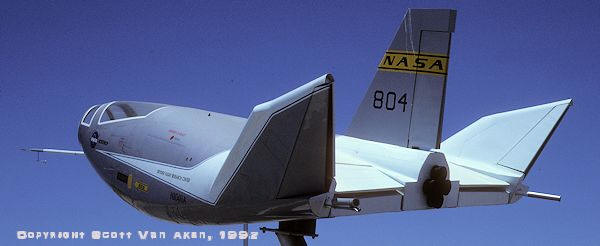 Cool photo of Bill Dana at this link
Cool photo of Bill Dana at this link